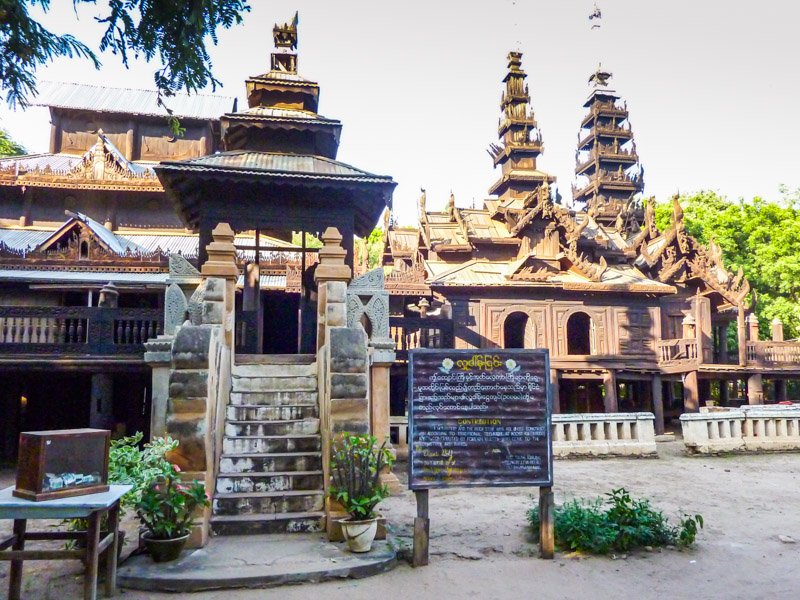We visited this monastery on our second day in Bagan in 2009. This was the only monastery we visited while in Bagan. According to Sylvia Fraser-Lu, this is possibly the oldest monastery in the Taung Bi area of Bagan (Pagan).
Location: Close to the Irrawaddy riverbank in Taungbi, and to Old Bagan.
Year Built: It is probably 200 years old. This is from a travel account. There are no written records, according to one source.
Builder: Since it is one of the oldest monasteries, it’s possible King Anarwatha was the builder.
Architectural details: The oldest teak monastery in Bagan. Others like it most likely existed but because of the nature of wood, these other buildings have not survived the years. It includes two monasteries, two pagodas with open-sided pavilions (tazaung), three standing Buddha images inside one of the pavilions, three rest houses (zayat) with kitchens and bathrooms for the monks and laity who live and practice there. Beautifully carved doors
Construction: This monastery was built with teak and padauk wood. The monastery is now surrounded by palms and padauk trees. Its continued existence is a testament to how strong and resistant to humidity these woods are. Within the Burmese architectural tradition, Nat Taung Kyaung boasts a number of towers with multilayered roofs, called pyatthat. The structure sits on a wooden platform that forms its base. Intricate carvings decorate the columns and doors and other architectural elements of the monastery.
Renovations: Restoration work is done as needed. According to Fraser-Lu, most of the wood carvings date to the late Kon-baung period. There were also room extensions added on the south and northwest sides during the colonial period.
Historical Periods: The colonial period began after the overthrow of King Thibaw in 1885. Thankfully, before all of the antiquities were trashed and repurposed, the Ancient Monuments Preservation Act passed in 1904. This required the Archaeological Society of India with the new Department of Archaeology in Burma, to compile a list of protected monuments. By 1916, 500 monuments and site in Burma were added, but only eight wooden monasteries were added.[Fraser-Lu, p. 137]
Current Use and Highlights: This is an active monastery with monastics living and practicing there. In 1996, Sayadaw U Thanwura, who presided here could name his lineage going back ten predecessors (about 200 years), giving this monastery a venerable status. I don’t know who is there now, so the lineage may go back even farther now.
Reference: Splendor in Wood: The Buddhist Monasteries of Burma by Sylvia Fraser-Lu, 2001 by Orchid Press, p. 225-29.
References:
Ancient Pagan: Buddhist Plain of Merit, Donald Stadtner, River Books, 2013
Pagan: Art and Architecture of Old Burma, Paul Strachan, Kiscadale Publications, 1989
Guide to Bagan Monuments by Min Bu Aung Kyaing, U Zaw Min Aye (Zaw Press), 2007
Inventory Of Monuments In Bagan, Pierre Pichard, UNESCO, 8 volumes, 1992-2001
